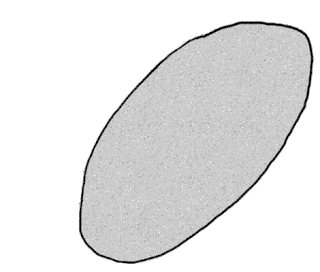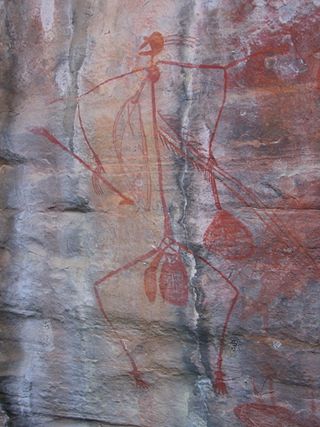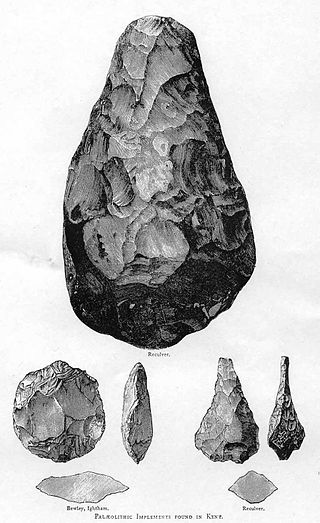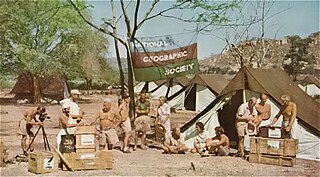Related Research Articles

Vere Gordon Childe was an Australian archaeologist who specialised in the study of European prehistory. He spent most of his life in the United Kingdom, working as an academic for the University of Edinburgh and then the Institute of Archaeology, London. He wrote twenty-six books during his career. Initially an early proponent of culture-historical archaeology, he later became the first exponent of Marxist archaeology in the Western world.

In archaeology, in particular of the Stone Age, lithic reduction is the process of fashioning stones or rocks from their natural state into tools or weapons by removing some parts. It has been intensely studied and many archaeological industries are identified almost entirely by the lithic analysis of the precise style of their tools and the chaîne opératoire of the reduction techniques they used.
In archaeology, lithic analysis is the analysis of stone tools and other chipped stone artifacts using basic scientific techniques. At its most basic level, lithic analyses involve an analysis of the artifact's morphology, the measurement of various physical attributes, and examining other visible features.

Sir John Grahame Douglas Clark, who often published as J. G. D. Clark, was a British archaeologist who specialised in the study of Mesolithic Europe and palaeoeconomics. He spent most of his career working at the University of Cambridge, where he was appointed Disney Professor of Archaeology from 1952 to 1974 and Master of Peterhouse from 1973 to 1980.

The prehistory of Australia is the period between the first human habitation of the Australian continent and the colonisation of Australia in 1788, which marks the start of consistent written documentation of Australia. This period has been variously estimated, with most evidence suggesting that it goes back between 50,000 and 65,000 years. This era is referred as prehistory rather than history because knowledge of this time period does not derive from written documentation. However, some argue that Indigenous oral tradition should be accorded an equal status.
Australian archaeology is a large sub-field in the discipline of archaeology. Archaeology in Australia takes four main forms: Aboriginal archaeology, historical archaeology, maritime archaeology and the archaeology of the contemporary past. Bridging these sub-disciplines is the important concept of cultural heritage management, which encompasses Aboriginal and Torres Strait Islander sites, historical sites, and maritime sites.

Use-wear analysis is a method in archaeology to identify the functions of artifact tools by closely examining their working surfaces and edges. It is mainly used on stone tools, and is sometimes referred to as "traceological analysis".

Burrunggui is located in an outlying sandstone formation of the Arnhem Land Escarpment within the Kakadu National Park in the Northern Territory of Australia. It is the traditional Country of the Gun-djeihmi speaking people and according to traditional owners, was shaped by Ancestral beings in the creation period of the Dreaming. It was included on the World Heritage Register. Kakadu National Park is included on UNESCO the World Heritage List due to its exceptional natural and cultural values.
Peter Dixon Hiscock is an Australian archaeologist. Born in Melbourne, he obtained a PhD from the University of Queensland. Between 2013 and 2021, he was the inaugural Tom Austen Brown Professor of Australian Archaeology at the University of Sydney, having previously held a position in the School of Archaeology and Anthropology at the Australian National University.
Derek John Mulvaney, known as John Mulvaney and D. J. Mulvaney, was an Australian archaeologist. He was the first qualified archaeologist to focus his work on Australia.
Kartan industry is the archaeological production, probably more than 10,000 years ago, of a large quantity of exceptionally large stone tools that were found on Karta, known since 1802 as Kangaroo Island, South Australia.
Harry Lourandos is an Australian archaeologist, adjunct professor in the Department of Anthropology, Archaeology and Sociology, School of Arts and Social Sciences at James Cook University, Cairns. He is a leading proponent of the theory that a period of hunter-gatherer intensification occurred between 3000 and 1000 BCE.
Professor Michael John Morwood was a New Zealand archaeologist best known for discovering Homo floresiensis. In 2012, he received the Rhys Jones Medal by the Australian Archaeological Association.

The University of Queensland Anthropology Museum is located in Brisbane, Australia. It houses the largest university collection of ethnographic material culture in Australia.

Alice Gorman is an Australian archaeologist, heritage consultant, and lecturer, who is best known for pioneering work in the field of space archaeology and her Space Age Archaeology blog. Based at Flinders University, she is an expert in Indigenous stone tool analysis, but better known for her research into the archaeology of orbital debris, terrestrial launch sites, and satellite tracking stations. Gorman teaches modern material culture studies, cultural heritage management, and Australian stone tools. Gorman is also a founding member of the Archaeology, Science and Heritage Council of For All Moonkind, Inc., a nonprofit organisation developing and seeking to implement an international convention to protect human cultural heritage in outer space.
Josephine Mary Flood, is an English-born Australian archaeologist, mountaineer, and author.

Frederick David McCarthy was an Australian anthropologist and archaeologist. He worked at the Australian Museum in Sydney and was Foundation Principal of the Australian Institute of Aboriginal Studies, with interests covering Australian archaeology, museology and Aboriginal rock art.
Valerie Attenbrow is principal research scientist in the Anthropology Research Section of the Australian Museum, a position she has held since 1989.
Madjedbebe is a sandstone rock shelter in Arnhem Land, in the Northern Territory of Australia, possibly the oldest site of human habitation in Australia. It is located about 50 kilometres (31 mi) from the coast. It is part of the lands traditionally inhabited by the Mirarr, an Aboriginal Australian clan of the Gaagudju people, of the Gunwinyguan language group. Although it is surrounded by the World Heritage Listed Kakadu National Park, Madjedbebe itself is located within the Jabiluka Mineral Leasehold.
Caroline Bird is an Australian archaeologist and educator. She specialises in women's studies, cultural heritage, and indigenous studies in the archaeological context, specifically early Australian archaeology. Bird's other focuses include lithic technology and art.
References
- ↑ Juparulla_Arts
- ↑ Biographical cuttings on Dr Johan Kamminga, archaeologist, ... from newspapers or journals, National Library of Australia, item 1932489
- ↑ Mulvaney, D. J. (Derek John); Kamminga, Johan; Brissenden collection (1999), Prehistory of Australia, Allen & Unwin, ISBN 978-1-86448-950-7
- ↑ Register of Consulting Archaeologists For proponents needing to undertake an Aboriginal Heritage Assessment in Tasmania
- ↑ Cotterell, Brian; Kamminga, Johan (1990), Mechanics of pre-industrial technology : an introduction to the mechanics of ancient and traditional material culture (1st pbk. ed.), Cambridge University Press, ISBN 978-0-521-34194-3
- ↑ Hilary Du Cros, Much More Than Stones and Bones: Australian Archaeology in the Late Twentieth Century, Melbourne University Press, 2002
- ↑ Kamminga, J, 'Observations of ground edge hatchets', Occasional Papers in Anthropology No 4 pp.161-7, Anthropology Museum, University of Queensland, 1980
- ↑ Barbara Thiel, The Archaeology of Central Philippine, A Study Chiefly of the Iron Age and Its Relationships (review), Asian Perspectives, Volume 44, Number 2, Fall 2005 pp. 392-395
- ↑ "Man in Australia 'at least 30,000 years'". The Canberra Times . 22 September 1981. p. 1. Retrieved 28 May 2015– via National Library of Australia.
- ↑ Alice Roberts, The Incredible Human Journey, A&C Black, 5 Apr 2010
- ↑ Challenging a Cambridge academic colony down under, Tertangala (University of Wollongong Students' Representative Council), Vol. 16, No. 2, June 1990, p. 8; Curio, Vol. 21, 11-20 June 1990, pp. 22-23; Academic colonies. Honi Soit, No. 2, July 1990, pp. 18-19
- ↑ James Woodford, 'Bones of contention block beach development', Sydney Morning Herald, 17 April 2004
- ↑ Chiang Mai Citylife 2015 Issue 02, The Art of Erecting a Garden